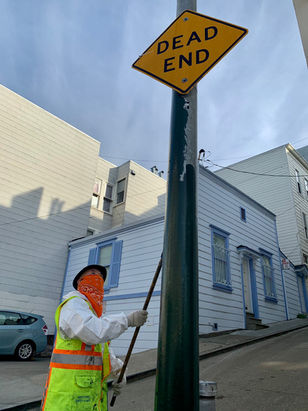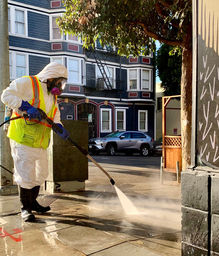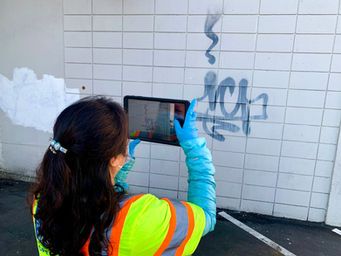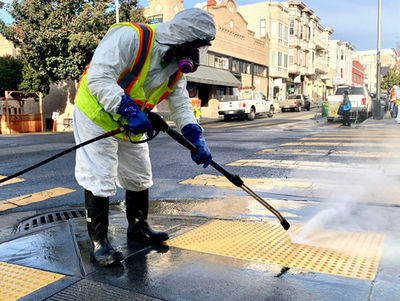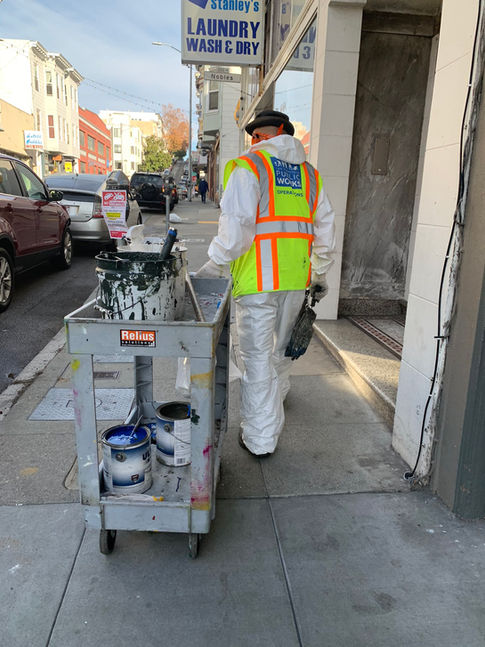STORIES
Timing is Everything
The new floating Fire Station 35 makes the move to its permanent home with clockwork precision.
Going Deep with
Deep Cleaning
CleanCorridorsSF is a special operation that deploys our street cleaners to a different neighborhood commercial district every Thursday.
Coming Soon:
Treecycle 2021!
From Jan. 4 through Jan. 15, Recology will be collecting Christmas trees for recycling throughout San Francisco.
Focus on Chinatown Shows Benefits of Teamwork
We spoke to Chinatown's business owners about their responsibilities of keeping this vibrant neighborhood clean, safe and pleasant.




Weathering the Storm
When a downpour hits, our crews jump into action, acting as first responders to fallen trees, flooding and overflowing storm drains.
New Bayview Community Center Virtual Topping Out
The new Southeast Community Facility celebrated an important construction milestone with an online ceremony for the topping off of its last beam.
2020 in Review
Travel back with us through 2020 as we take a look at our project milestones, new programs and COVID-19 response throughout the past year.





TIMING IS EVERYTHING
New Floating Fire Station Makes the Move with Clockwork Precision
The San Francisco Fire Department’s new floating fireboat station started to come to life in early 2019 some 6,100 miles away in Nantong, China, an industrial port city north of Shanghai located on the bank of the Yangtze River.


There, the steel barge that serves as the foundation of the fire station was manufactured. It then traveled across the Pacific last winter to Pier 1 on Treasure Island in the middle of San Francisco Bay.

After its arrival in January, construction began on the two-story fire station. Mooring lines kept the float in place on the Bay waters just off the Treasure Island shore.



Fast forward 11 months: With work complete on the 14,900-square-foot building, it was time to make the final move.

Just after midnight on that early Thursday morning, crews untethered the mooring lines from the holds on Treasure Island and attached the float to two tugboats, which guided the float to Pier 22 ½.
The timing seemed perfect: The Bay was in a period of slack tide when the water is void of powerful waves and current. But just as they were getting underway, the tugboat captain picked up a GPS reading that showed a massive container ship passing under the Bay Bridge and heading in their direction. The move was paused briefly until the ship had passed.
Their route, a distance of 2.88 nautical miles, took a little more than an hour. They encountered no obstacles along the way – no hidden sandbars nor humpback whales. “It was very smooth,” said William Knudson, a civil engineer who oversaw the highly choreographed operation as a project manager with Power Engineering Construction Co.



Arriving at Pier 22 ½, they were met by two push boats, on hand for what would be the most exacting part of the operation. There was very little room for error. The float, 173 feet long and 95 feet wide and weighing 3.3 million pounds, had to fit between four mooring piles that will hold the structure in place, with just four inches to spare on either side.
A tugboat pilot stood atop the float up front, and with everyone involved tuned to the same channel on the marine radio, he gave orders – move a little this way, a little that way, and this way again. Only he used maritime-speak as he made the directional commands needed to squeeze the float into place. The pre-work measuring and re-measuring the footprint between the four piles and the float itself didn’t disappoint – a perfect fit.


With sunrise still nearly five hours away, crews hustled to secure the float. They used a crane to position four massive steel collars weighing 10,000 pounds apiece that connect the float to the piles. Forty 1 ¼-inch bolts attached each collar.

The steel piles, at 125 feet long and 60 inches in diameter, were set in place in early fall. A crane hoisted them vertically into the water, where they sank about 50 feet into the Bay mud, just by their sheer weight. Then, a mechanized vibratory hammer weighing 70,000 pounds drove them down deeper, a third of an inch at a time with each cycle. Two of the piles are anchored in 90 feet of dense Bay mud; the other two in 90 feet of thick mud and bedrock. A specially trained crew of pile drivers hammered each pile into place. Boring samples taken two years ago determined their exact location and depth.
Six months before specialized crews transported San Francisco’s new floating fireboat station across the Bay from Treasure Island to Pier 22½, just north of the Bay Bridge, the project team plotted the optimal day and time. The decision? Just past midnight on Dec. 3.
“We knew we wanted to do it at night when the wind and waves are at minimum and there’s less boat traffic on the Bay,” said Knudson, who rode in a small skiff alongside the floating fireboat station as it traveled to its permanent home.
As a bonus, the waning moon – just one day past full – provided plenty of ambient light for the overnight move.
San Francisco’s new floating fire station is thought to be the only structure of its kind in the world.
Once the utilities are hooked up and the finishing work and inspections are complete, the building will replace the Fire Department’s existing Fireboat Station 35 – located on dockside and serving the City’s waterfront since 1915. A designated City landmark, the historic building has been deemed too small and outdated to adequately serve modern-day San Francisco. It also doesn’t meet today’s seismic-safety codes and could be at risk of flooding due to sea level rise.
One of the biggest advantages of the floating fire station is that it was designed to rise and fall with the natural tide of the Bay, king tides and future sea level rise that is projected due to global warming.
The Station 35 crew is scheduled to move into their new digs this coming spring. The planning phase of the project began in 2016.
As for the old fireboat station, it will house a fire engine and also be used to store equipment. The San Francisco Fire Department's three fireboats and rescue watercraft will be berthed at the new floating facility. Community members will have access to a new waterfront observation deck being built on the south side of the station.
The $39.9 million project is funded by the second phase of the Earthquake Safety and Emergency Response (ESER) Bond, which passed with 79 percent approval of San Francisco voters in June 2014. The first phase of the bond program passed in 2010 and a third phase in 2020, both with overwhelming support.
Swinerton-Power (the joint venture of Swinerton and Power Engineering Construction Co.), constructed the design-build project. Shah Kawasaki Architects provided the building design, and Liftech Consultants Inc. provided the marine design/barge. The San Francisco Public Works Building Design and Construction Division is managing the project on behalf of the San Francisco Fire Department.
If you'd like to learn more about the project, check out this special episode of Snapshots LIVE! where panelists discuss the details of how this project came about and what's in store for 2021.


Going Deep with Deep Cleaning
Armed with a sharp hand tool to dig out weeds from sidewalk cracks and between the gutter and curb,
Jamir Nathan moved along a North Beach block inch by inch scraping away unwanted plants the size of a fingernail. “You’ve got to really go after them and get the dirt they’re growing in between the cracks,” he said. “You can’t just leave a little because they’ll grow back.”
Around the corner from Nathan, Tommy Lam used a power washer to scour away a thin film of soot covering the bright yellow curb ramp. Down the block from them, Yizheng Yu painted over graffiti tags marring a lamppost and Mark Simmons swept up leaves and litter.
Nathan, Lam, Yu and Simmons worked along Grant Avenue in North Beach on Dec. 10 as part of the CleanCorridorsSF team. The special operation deploys a large contingent of San Francisco Public Works street cleaners to a different neighborhood commercial district every Thursday morning to power wash and sweep the sidewalks, flush down the roadway and wipe out graffiti – a coordinated deep-cleaning blitz resulting in noticeable improvements to the cleanliness of the targeted area.
Click on the gallery!
A week later, Haight Street in the Haight-Ashbury got the CleanCorridorsSF treatment. Interested in what neighborhoods are next? Here’s the upcoming schedule:
-
Jan. 7, 2021: Clement from Fourth Street to Ninth Street
-
Jan. 14, 2021: Geneva from Mission to Edinburgh
-
Jan. 21, 2021: – Folsom from Sixth Street to 10th Street
-
Jan. 28, 2021: Valencia from 16th Street to 21st Street
-
Feb. 4, 2021: Hayes from Franklin to Webster
-
Feb. 11, 2021: Leland from Bayshore to Delta
-
Feb. 18, 2021: 24th Street from Bartlett to Folsom
-
Feb. 25, 2021: Ocean from Plymouth to Faxon
-
March 4, 2021: Judah from La Playa to 44th Avenue
-
March 11, 2021: Fillmore from Post to Eddy
-
March 18, 2021: Mission from Persia to Silver
If you’re in one of those areas when work is underway, stop by and say hello to our crews and goodbye to the weeds, litter and graffiti tags.


Coming Soon: Treecycle 2021!
Disposing of your Christmas tree might not be the most enjoyable holiday tradition, but thanks to Public Works and our partners at SF Environment and Recology, it doesn’t have to be a major inconvenience either.
For the last 34 years, we’ve been holding an annual “Chipping of the Trees” – a post-holiday operation that turns unadorned Christmas trees into earth-friendly mulch.
From Jan. 4 through Jan. 15, Recology will be collecting trees for recycling throughout San Francisco. All you need to do is place your tree on the curb next to your bins the night before your regularly scheduled collection day and Recology will take care of the rest.
Before you take your tree out, please make sure you've taken off all lights and ornaments, and do not cover or wrap your tree in plastic. If your tree is over 6 feet tall, please cut it in half or we will not be able to take it away.
What happens after we pick up the trees? They’re sent through a woodchipper and repurposed as mulch, which then is used to provide nutrients to soil and prevent weed growth in parks around the City. The 500 tons of trees collected each year through this program create more than enough mulch to go around.
Tree recycling is part of our “Love Our City” campaign that encourages everyone in San Francisco to pitch in to help keep San Francisco clean and looking beautiful. Even little things, like setting out your Christmas tree on your regularly scheduled collection day, will help us keep our streets and sidewalks safe and clean!



Focus on Chinatown Shows Benefits of Teamwork
Early morning on Stockton Street, the main commercial corridor in Chinatown, bursts with life:
Pallets of deliveries await being brought inside the stores; merchants set up merchandise displays on the sidewalk with the hope of a profitable day; early-bird shoppers pick out fresh produce from newly opened boxes.
Unfortunately, there are times when the bustle of business creates problems: blocked paths of travel, making it hard for people on foot to navigate safely along the sidewalk; and unsightly garbage that wasn’t disposed of properly, blemishing the cleanliness of the historic neighborhood.
Some local merchants brought their concerns to us and asked for assistance. Our response: Of course!
On Dec. 9, a Public Works team with representatives from our street cleaning, inspections and community engagement bureaus conducted a merchant walk in Chinatown to speak with business owners about their responsibilities of keeping this vibrant neighborhood clean, safe and pleasant for everyone.


Team Public Works started the merchant walk at 8 o’clock in the morning and focused on illegal dumping, unlawful sidewalk sales, graffiti and overflowing blue, black and green refuse bins. The goal of the visit was to help merchants better understand the laws they must comply with to keep public areas safe and clean, which in turn will help businesses thrive by creating a more welcoming shopping district.
As our employees went door to door, patrons stopped to thank them for being there. Business owners cooperated with our staff and made immediate corrections to comply with the health and safety codes. We have more merchant walks coming up and we’re preparing to conduct stakeouts to catch people who leave behind illegal dumping, including cardboard. Meanwhile, our dedicated street cleaning crews will continue their daily runs through Chinatown.
All of us need to work together to care for our neighborhoods. The benefits are worth it!


Weathering
the Storm
Despite San Francisco’s moderate climate, its winter storms can wreak major havoc on the public right of way.
The heavy rain and high winds can cause flooding, downed trees, potholes and sewer backups, all of which pose health and safety threats to the community. This is why Public Works has developed a comprehensive approach to storm preparation and response that draws from the expertise of staff from across the department.
Many of these efforts take place well before storms even enter the forecast, as the City’s trees and roads need regular maintenance throughout the year to withstand the winter elements. Our Engineering Division constantly studies and collects data on the City’s flood-prone areas in an effort to limit flooding and related damage.
Similarly, the Bureau of Urban Forestry maintains San Francisco’s street trees, preparing them for harsh weather by keeping them trimmed to minimize branch failure during high winds. Our Bureau of Street and Sewer Repair even distributes sandbags free of charge each winter to San Franciscans whose homes and businesses are susceptible to flooding.
When a downpour begins to hit, our Bureau of Street Environmental Services crews jump into action, acting as first responders to 311 calls reporting fallen trees, localized flooding or manhole covers displaced by overflowing storm drains and flooding. Once these crews assess the situation, they either handle it themselves or call on our Bureau of Urban Forestry arborists if the job involves fully downed trees or massive limbs. Storm-related damage to City streets can emerge weeks after the fact. This is where the Bureau of Street and Sewer Repair comes in.
Their crews diligently fill potholes and pavement cracks that occur when the soil beneath roadways becomes saturated with rainwater. Crews also respond to sinkholes.
Want to learn more about these efforts? Watch the newest installment of SnapshotsLive!, Public Works’ new webinar series, to get the inside scoop. This month, we got the rundown on storm response from Urban Forestry’s Superintendent Carla Short, hydraulics engineer Bimayendra Shrestha, Street and Environmental Services Superintendent Peter Lau and Matt Naclerio, who heads the Bureau of Street and Sewer Repair.


Virtual Ceremony Marks Construction Milestone for New SOUTHEAST Community Center
There’s a ritual in the world of building construction known as the topping out ceremony.
In normal times, the milestone event draws construction workers, dignitaries, community leaders and the project team to cheer as the final steel beam is placed atop the structure – officially marking completion of the building’s steel framing. The beam, hoisted by crane, usually sports an American flag at one end and a small evergreen tree on the other.
But this year is no ordinary time, with the COVID-19 pandemic upending most everything. So instead of hosting a topping out celebration in person, the project team behind the City’s new Southeast Community Facility, now under construction in the Bayview, noted the occasion with a virtual event. Hundreds of people viewed the speeches and beam-raising online.

The new Southeast Community Facility, owned and operated by the San Francisco Public Utilities Commission (SFPUC), will sport a large, state-of-the-art special events space and multi-purpose space for meetings, events, dance classes, community gatherings and daycare services. There also will be coworking space for community organizations, a meditation garden and a playground.
The three-story, 45,000-square-foot structure at 1550 Evans Ave. in the Bayview is set to open next year. It will replace the current community center at 1800 Oakdale Ave., which was built in the 1980s to mitigate the environmental and social impacts of the SFPUC’s sewage treatment plant’s expansion in the neighborhood.
Public Works is a key partner in the replacement project, providing architecture, landscape architecture, construction management, mechanical engineering, electrical engineering, structural engineering and hydraulic engineering services. Our site assessment and remediation and permitting teams also have been involved. It’s an exciting undertaking that will serve the neighborhood for generations.
Let’s hope that by the time the ribbon-cutting rolls around, the COVID-19 pandemic will be under better control and we can celebrate its grand opening in person.
A Look Back at 2020
The COVID-19 pandemic seared a devastating brand onto 2020 that will not be removed: Nearly 1.7 million deaths worldwide, including more than 300,000 in the United States, and more to come. Tens of millions more people testing positive for the virus. A broken economy with job loss, shuttered businesses and loss of income and revenue. Family gatherings, community celebrations, travel and in-school learning curtailed. The ravages are real and still unfolding.
But the year also showed us human compassion, ingenuity, resourcefulness, resiliency and hope.
At the onset of the pandemic in the spring, San Francisco Public Works embraced the mantra for our staff and the communities we serve: We will get through this, together. And we have been doing just that.
Our employees, all deemed essential workers, have been on the job throughout the health crisis, whether working on COVID-response initiatives, such as developing safe sleeping sites for San Francisco’s unhoused residents and readying COVID testing sites, or advancing our core work, such as cleaning streets, paving roads, pruning trees, issuing street-use permits and designing and managing the City’s capital projects.
The annual Year in Review feature in our In the Works digital journal captures a representative look at our work in 2020. Please take a look.
November
November 18
City officials, elementary school students and community leaders inaugurated “Hop, Skip and Play on Omar Way” – a 176-foot-long interactive sidewalk mural that sparks the imagination of young people and gets them moving.



November 10

Work wrapped up on a $15-million makeover of the Maxine Hall Health Center that includes seismic upgrades, expanded exam rooms for families and a much-needed elevator to improve accessibility of the two-story facility.
October

October 24

San Francisco recorded 4.02 inches of rain on Oct. 24, making it the fourth wettest day recorded since the
Gold Rush era. The torrential downpour, coupled with high winds, took a toll on our urban forest: More than 900 service requests for toppled trees and fallen limbs landed in our work queue, but our Bureau of Urban Forestry crews didn’t miss a beat.

In Progress
Transformative. Inspired. Community. Those three words begin to capture the essence of the freshly remodeled Margaret Hayward Playground in the heart of San Francisco that’s set to open soon. Bounded by Turk, Golden Gate, Gough and Laguna streets on the eastern edge of the Western Addition, the reimagined 6-acre community hub is sure to be a crowd-pleaser.
September
Public Works, in collaboration with the industrial designers at the Institute for Creative Integration (ICI), narrowed the design of the City’s new public trash cans to three final concepts, which people were invited to provide feedback for and choose their favorite.

September 21

In Progress
Construction continued on San Francisco’s new state-of-the-art animal shelter, which is on schedule to open early next year. Located at 1419 Bryant St. in the Mission District, the facility will provide a safe and humane shelter for the City’s population of lost, abandoned, sick and injured animals. Watch a Snapshots Live! webinar that takes you behind-the-scenes.

In Progress
The Better Market Street project team unveiled an updated design for the proposed revitalization of the prominent San Francisco corridor to reflect changing demands. The planned changes come after the directors of the five government agencies involved in Better Market Street directed the project team to reassess the design and implementation of the overall project. The Better Market Street project, managed by San Francisco Public Works, aims to deliver transformative transportation, streetscape and safety improvements along 2.2 miles of Market Street between Octavia Boulevard and Steuart Street.
Near Completion
Crews finish the concrete work on the newly renovated Garfield Pool before filling it with water, signaling that the nearly two-year improvement project will be wrapping up soon. The overhaul included a makeover of the existing pool structure and demolition and construction of the adjacent clubhouse.
August

One month, 31 days
One month. 31 days. For each day in August, we featured one service or program that took place during the month. Whether it was building, planting, repairing or designing, we worked 24/7 to serve San Francisco! Check out the special August issue of In the Works.



July

120 years of service
In July's special edition of In the Works, we featured images and stories from 120 years of serving San Francisco. Check it out!
June
June 22-30
Each year around this time, a Public Works contractor redistributes more than 16,000 cubic yards of sand, moving it from the side of the Great Highway toward the ocean. The goal is to reduce the likelihood of sand buildup on the roadway during windy weather. Learn more.
On a foggy morning in San Francisco, our asphalt and sheet metal shops installed a guardrail along Twin Peaks Boulevard. They first dug 4-ft holes for posts, then attached and bent the galvanized steel rail to match the curvy road. Learn more.

June 24
May

May 23
Over the Memorial Day holiday weekend, demolition crews removed the outdated bridge over Geary Boulevard – slab by slab – in a methodical operation that involved cranes, excavators, blow torches, crowbars and engineering know-how. Learn more.

May 1
San Francisco Public Works completed a two-year, $27 million rehabilitation and renovation project on the historic Third Street Bridge.
Construction wrapped on the Baker Beach Green Streets Project, aiming to beautify the neighborhood and better manage stormwater before it enters the City’s combined sewer/stormwater system.

Throughout May
April
There are few times in our lives when we know immediately that what we’re experiencing is historic. With the COVID-19 pandemic, San Francisco Public Works employees, as designated essential workers, were on the front line of the City’s response, putting their know-how and moxie to good use. Check out our special edition of In the Works devoted to our pandemic response.







March

March 17

The shelter in place order, which went into effect March 17, tested our resources and revealed our resiliency. Front-line staff remained on the job with essential services to keep our city safe, clean and functional – from cleaning the streets and responding to tree emergencies, to inspecting construction sites in the public right of way and revamping public health facilities to respond to the COVID-19 pandemic.

March 10
Public Works took part in a celebration for the new safety improvements along a busy stretch of the Townsend Street corridor. The project, on Townsend, between Fourth and Fifth streets, includes protected bicycle lanes, a pedestrian island to shorten the crossing distance from curb to curb, a new sidewalk, new curb ramps and bus loading islands.

March 2


We celebrated the opening of the wonderful Turk-Hyde Mini Park in the Tenderloin. Learn more.
February

February 22


Nearly 200 volunteers fanned out across the Mission and Bernal Heights neighborhoods to plant trees, paint out graffiti, pick up litter and beautify medians for the month’s Community Clean Team workday – getting a lot of good work done under brilliant blue skies.

Throughout February
Public Works engineers assessed erosion along southbound Great Highway near Sloat Boulevard, adjacent to Ocean Beach. By opening the asphalt, our engineers could get a good look beneath the surface and a better understanding of the cause of the erosion.

February 13


San Francisco Public Works launched SidewalkSpotlightSF, a new initiative to perform a special deep clean of busy neighborhood corridors throughout the City, with a focus on litter removal, steam cleaning, graffiti abatement, trash pickup and public education.

February 8
Tens of thousands of celebrants cheered lion and dragon dancers, marching bands and beautifully decorated illuminated floats in San Francisco’s wildly popular Chinese New Year Parade to celebrate the Year of the Rat. Once the parade passed, a crew of 60 Public Works street cleaners got right to work, swiftly scrubbing down the parade route from Second and Market streets to Kearny and Pacific streets.
January
Starting at 6 a.m. on Jan. 29, the City banned the use of private automobiles along a 2.2-mile stretch of Market Street eastbound from 10th to Main streets and westbound from Steuart Street to Van Ness Avenue. Commercial vehicles, transit, taxis and paratransit are still allowed on that stretch of Market Street.

January 29

January 28
Alaric Degrafinried was appointed acting director of San Francisco Public Works on January 28, 2020. He most recently served as City Purchaser and Director of the San Francisco Office of Contract Administration.
January 11
Community Clean Team Turned 20! - Portsmouth Square in Chinatown is no stranger to bustling crowds and lots of activity, but the action picked up as we kicked off the 20th anniversary of Community Clean Team in grand fashion with traditional lion and dragon dances and a firecracker show. More than 300 volunteers took part in the workday.






